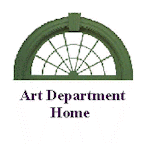What Can an Art Teacher Do?
I write this in the wake of the tragic
terrorism in New York and elsewhere on September 11, 2001. Are there better
ways to respond in conflict situations? As art teachers we have unique
opportunities and obligations. How does my art classroom and curriculum
help produce better citizens and a better world? What can an art
teacher do?
-
I must
model positive interaction with my students and my colleagues. I
must nurture mutual caring and respect. I must model, facilitate,
and clarify acceptable behavior, and move beyond the use of threats and
flagrant power in relationships. The art class can be a place to
learn the art of community building.
-
I must
set policies that reward healthy interaction and never reward or agree
with derogatory and judgmental behavior. I and the class must develop and
agree on clearly articulated guidelines for positive and honest rational
critique methodologies. When a student insults another student or another
student's artwork, I and the students need to question it. We must
develop parameters of acceptable civilized ways to express our opinions
in our artwork, our speech, and our actions. We must learn that questioning
and tolerance instead of brash or ill founded opinions works better than
insults. Because of the complexities of an art class, it becomes a micro
community
where civic lessons are learned every day.
What are the of purposes of art that
speak to tragic events? On a daily basis, what can an art teacher do?
-
I can
encourage observations and expressions that deal with real experience so
that art becomes a good way to celebrate success and pride, as well as
to express anger and frustration in healthy, positive, non-violent ways.
A
important purpose of art is to provide a medium of nondiscursive expression.
-
I can
give some assignments that are structured to help students grapple with
their own bad feelings. Working things out visually is healthier and
more helpful than acting out irrationally against others.
-
In graphic
design classes and other classes, I can use fewer commercial art assignments
and more public service projects. Topics can focus on healthy life
styles, improving our environment, the sacredness of life, better personal
habits, and more tolerant attitudes and compassion for others. Posters
and murals are some obvious art forms to use in working against violence,
hate, and revenge as ways to resolve difficulties. A important purpose
of art is to speak the truth whether it is beautiful or not.
-
I can
also encourage students to create art that expresses the unfairness they
have experienced in their own lives. I can also reward those that find
uplifting and positive solutions and alternatives to unfairness and prejudice.
At the end of such a lesson we can discuss the work of artists like Gordon
Parks, Faith
Ringgold, and Cindy
Sherman who express truth about unfairness that they have experienced
and observed. A important purpose of art is reveal things that have
been unnoticed by those less sensitive, less aware, or less impacted.
-
I can
give assignments to produce artwork specifically for healing. We
need more Maya Lins who give us ways to heal in aftermath of violence.
If this is a high school class, at the end of such an assignment, I can
compare Maya Ying Lin’s
memorials with Picasso’s “Guernica”
and Goya’s
“Disasters of War”. I can point out that in Goya’s time there
was no photography or television, so this work, like photo journalism today,
was intended to expose, not glorify violence. A important purpose of
art is to help heal our wounded selves and redeem our souls.
As an art teacher,
I continue to believe our first obligation is to teach in ways that produce
competent and truthful artists. Bad artwork advocating a good cause
will not be effective. Clever artwork advocating untruth, unfair generalizations, and prejudice is even
worse.
Marvin
Bartel - September 13,
2001

"Shadows"
bartel 2001
See Art
Education Links by the same author recently UPDATED to include the teaching of drawing, scupture,
pottery, art history, creativity, how to teach idea generation, transfer of learning, and so on.
See Mark & Judith Decker's teaching links to Art About Peace and the Vietnam Memorial. Art teachers will find many great teaching ideas at this web site
Author: Marvin Bartel, Ed.D., Professor of Art, Goshen College, Goshen,
IN 46526
© 2001 - All rights reserved. You are encouraged
to provide links to this page, but to make printed copies or to include
as part of another web site, you must have permission. To comments about
this article or request permission to copy contact the author

click this image for larger view
Back to Goshen College Home Page
Marvin Bartel Home
Marvin Bartel Courses
Goshen College Art
Gallery
see update date at top of page

Back to Art Education
Home Page
|


